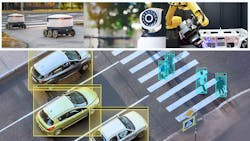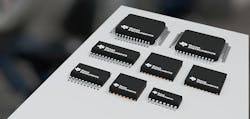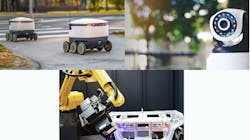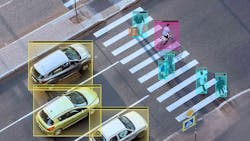Members can download this article in PDF format.
Embedding technology is the new frontier for smaller, faster, more powerful, integrated semiconductors. It brings a variety of features and functions in complex, small-footprint devices across a wide range of platforms. Trends in embedded technology will allow microcontrollers (MCUs) and microprocessors (MPUs) to be more energy-efficient, smaller, and feature-packed.
These MCUs and MPUs are creating expanded capabilities in emerging areas such as the IoT, autonomous vehicles, industrial robots, wearables, medical devices, and especially at the edge, in smart cities, and artificial intelligence (AI).
As AI gains traction in smart cities, small, low-power, embedded devices will ramp up the intelligence of connected devices in everything from street lamps to parking meters to information kiosks.
What Will They Bring?
Next-generation MCUs, such as the MSPM0 Cortex-M0+ MCU series from Arm, enable emerging applications in fields like sensorless field-oriented-control (FOC) motor-drive and polyphase energy-metering computation in grid infrastructures. These applications benefit from new MCU features, such as zero-drift, chopper-stabilized, programmable-gain operational amplifiers and integrated transimpedance amplifiers with ultra-low input bias current (150 pA).
Such MCUs are capable of enhanced performance. They offer a 12-bit operation at up to 4 Msamples/s and 14-bit operation at up to 250 ksamples/s, as well as featuring a very attractive price/performance ratio. This means that applications such as battery charging, motor-drive monitoring, medical-device monitoring, and similar cost- and dimension-constrained applications can now be cost-effectively developed.
As MCUs become more and more complex, they will also drive forward applications that are currently less eco-friendly and feature constrained. These include energy-management systems, security, infrastructure, transportation, and more. This will be accomplished by emerging heterogeneous processors with simplified designs and higher integration levels. In turn, it will reduce the need for multiple peripheral function chips.
Heterogeneous processors integrate different types of components—e.g., general-purpose CPUs, specialized digital signal processors (DSPs), and graphics processing units (GPUs)—on a single chip. This will infuse embedded hardware across many more segments and industries by enabling integrated, optimized processing for more complex and diverse speed-intensive tasks such as signal processing, graphics rendering, war recognition, and surveillance/camera systems.
The IoT
For the IoT, or the internet of anything and everything (IoX) as I like to refer to it, embedded technology will bring advanced intelligence to simple devices now only marginally connected. This trend interfaces next-generation sensors, wireless modules, network stacks, and protocols with multifunction processors to create an intelligent network of interconnected devices.
Hardware, across the landscapes of household appliances, wearables, vehicles, utilities, computing devices, cars, and more will be able to act intelligently—not just be connected.
AI and the Edge
Artificial intelligence and the edge are, perhaps, the most exciting fusion on the horizon. Today, most experts agree that, soon, most processing will be done at the edge. It will be accomplished by specialized processors, both embedded and standalone. Embedded processors will be found in AI-based neural networks and hardware accelerators for machine learning (ML).
As AI and ML evolve at the edge, the driving forces for developing devices will be intelligence, environmental awareness, size and power sensitivity, and smaller footprints. The closer the hardware is to the source, the faster the decision-making. This also benefits privacy and security. And there’s reduced reliance on cloud- or core-based AI processing.
For example, applying AI to vision processing brings about a whole new world of visual information and control possibilities. Not just for facial recognition, but the ability to integrate embedded processors in all types of camera and robotic applications.
Using state-of-the-art camera systems with embedded processors, applications such as security cameras, autonomous mobile robots, autonomous vehicles, industrial automation military and public safety, just to mention a few, can be monitored by smart cameras. Analytics would be performed—and action taken, if desired—at the edge.
Security and Trust
With the growing number of connected devices, security has become a monumental concern. A requirement for embedded processors is that they be designed with built-in security features—e.g., hardware encryption, secure boot, and secure key storage—to protect sensitive data and ensure the integrity of the system.
A Wide Playing Field
Embedded processors have a bright future, beyond what has been discussed so far. Areas such as remotely piloted vehicles (RPVs), consumer electronics, aerospace and defense, education, transportation, logistics, and infrastructure are but some others.
Embedded-processor applications in the autonomous-vehicle space include engine management, braking systems, and stability control, infotainment systems, GPS navigation, and driver assistance systems (ADAS).
In consumer electronics, the field is extremely broad. Devices include smartphones, tablets, digital cameras, smart TVs, portable media players, set-top boxes and gaming consoles, home automation, and more.
Embedded processors are critical for aerospace and defense applications. They’re used in avionics systems, flight control systems, unmanned aerial vehicles (UAVs), radar systems, communication systems, hardened war-fighter equipment, weapons, and munitions.
Logistics offers a myriad of opportunities for embedded systems. Telematics and fleet-management applications use embedded processors in their telematics systems to collect and transmit data from vehicles in real-time. Data includes location information, engine diagnostics, fuel consumption, and driver behavior. They also leverage embedded processors for real-time data analysis, as well as to optimize routes, monitor vehicle performance, and improve operational efficiency.
Logistics content will be a prime candidate for embedded processors. Logistics hubs and sorting centers will use embedded hardware to manage the tracking and sorting of packages. Embedded processors will find homes in barcode scanners, RFID readers, and imaging.
As the transportation infrastructure expands to accommodate the vehicle ecosystem, embedded processors will enable intelligent traffic lights, parking-management systems, tolling systems, vehicle-to-vehicle (V2V)/vehicle-to-infrastructure (V2I) communications, real-time weather and traffic data, and more.
Conclusion
Going forward, embedded processors will become faster, smarter, smaller, more energy-efficient, and more complex. Along that path, they will integrate other specialized hardware, setting a path to the heterogenous hardware mentioned above. The embedded processors industry will be one to watch as it will maintain a footprint in just about, if not every, electronic platform of the future.



